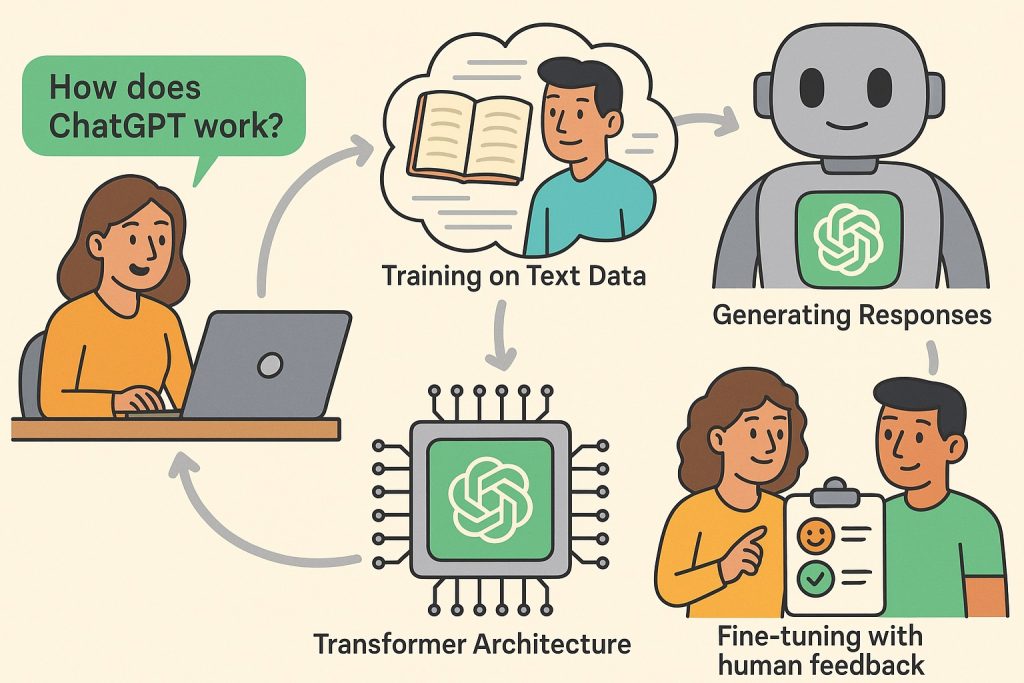ChatGPT is a type of artificial intelligence (AI) designed to understand and generate human-like language. It powers chatbots, virtual assistants, and creative writing tools, offering answers, explanations, or even stories in a natural and conversational way. But what exactly happens behind the scenes when you ask ChatGPT a question? This article breaks down the key concepts that make ChatGPT work.
What Is ChatGPT?
ChatGPT is an AI chatbot built on the GPT (Generative Pre-trained Transformer) architecture developed by OpenAI. The current versions (like GPT-4) are trained on vast amounts of text data from the internet, books, code, and more, enabling the model to predict and generate relevant text responses.
How It Works — Step by Step
1. Training on Text Data
Before it can answer questions, the model is trained using a process called unsupervised learning:
- It analyzes billions of sentences to learn how words relate to each other.
- It doesn’t memorize answers but learns patterns in grammar, tone, and meaning.
- The result is a model that can predict the next word in a sentence — the foundation of its conversational ability.
2. Transformer Architecture
ChatGPT uses a neural network design called a transformer, which is especially good at:
- Handling long pieces of text
- Understanding context and relevance
- Processing input in parallel (which makes it fast)
The attention mechanism inside transformers allows the model to focus on important words and relationships in a sentence to generate coherent replies.
3. Fine-Tuning with Human Feedback
After pre-training, the model undergoes reinforcement learning with human feedback (RLHF):
- AI trainers rank model outputs by quality.
- The model learns which responses are most helpful, safe, and aligned with human values.
- This makes ChatGPT better at following instructions and avoiding harmful content.
4. Generating Responses
When you type a message:
- Your input is broken down into tokens (parts of words).
- The model calculates probabilities for the next token based on your input and past tokens.
- It selects and assembles the most likely words to form a complete, relevant answer.
What ChatGPT Can Do
ChatGPT is capable of:
- Answering questions on science, history, and more
- Writing essays, stories, or code
- Translating languages
- Summarizing articles
- Roleplaying or tutoring
- Assisting with brainstorming or planning
Its usefulness depends on the clarity of your input and how well it aligns with the model’s training.
Limitations
Despite its power, ChatGPT has some known limitations:
- It doesn’t “know” facts the way humans do — it predicts text based on patterns.
- It may generate false or outdated information, especially if the training data is old.
- It doesn’t have real-time awareness, emotions, or personal experiences.
- It may produce biased or inappropriate content if safeguards fail.
These issues are being actively addressed by developers to improve safety and reliability.
Conclusion
ChatGPT works by blending massive data training, advanced neural networks, and human fine-tuning. While it doesn’t truly “understand” in the human sense, it mimics natural language impressively well. Whether you’re using it to learn, create, or automate, ChatGPT represents a major step in making AI language tools accessible and useful.
Glossary
- Artificial intelligence (AI) – Technology that mimics human intelligence.
- GPT (Generative Pre-trained Transformer) – The model family ChatGPT belongs to.
- Transformer – A type of neural network designed for language tasks.
- Token – A chunk of text (often part of a word) used in AI language processing.
- Attention mechanism – A feature in transformers that lets the model prioritize important words.
- Reinforcement learning with human feedback (RLHF) – A training process that improves model behavior using human preferences.


